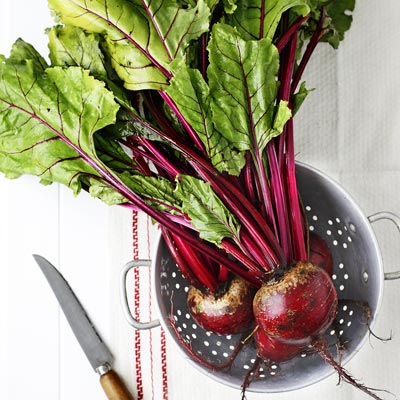
When inflammation is out of control—as in rheumatoid arthritis—it can damage the body.
Inflammation is part of the body’s immune response; without it, we can’t heal. But when it’s out of control—as in rheumatoid arthritis—it can damage the body. Plus, it’s thought to play a role in obesity, heart disease, and cancer.
Foods high in sugar and saturated fat can spur inflammation. “They cause overactivity in the immune system, which can lead to joint pain, fatigue, and damage to the blood vessels,” says Scott Zashin, MD, clinical professor at the University of Texas Southwestern Medical Center in Dallas.
Other foods may curb inflammation. Add these items to your plate today.
14 foods that fight Inflammation
Beetroot
This vegetable’s brilliant red color is a tip-off to its equally brilliant antioxidant properties: Beets (and beetroot juice) have been shown to reduce inflammation, as well as protect against cancer and heart disease, thanks to their hearty helping of fiber, vitamin C and plant pigments called betalains.
Fatty Fish
Oily fish, like salmon, mackerel, tuna and sardines, are high in omega-3 fatty acids, which have been shown to help reduce inflammation. To get the benefits, however, you need to eat fish several times a week, and it should be cooked in healthy way
Whole Grains
Consuming most of your grains as whole grains, as opposed to refined, white bread, cereal, rice, and pasta can help keep harmful inflammation at bay. That’s because whole grains have more fiber, which has been shown to reduce levels of C-reactive protein, a marker of inflammation in the blood, and they usually have less added sugar.
Dark Leafy Greens
Studies have suggested that vitamin E may play a key role in protecting the body from pro-inflammatory molecules called cytokines—and one of the best sources of this vitamin is dark green veggies, such as spinach, kale, broccoli, and collard greens. Dark greens and cruciferous vegetables also tend to have higher concentrations of vitamins and minerals—like calcium, iron, and disease-fighting phytochemicals—than those with lighter-colored leaves.
Nuts:
Another source of inflammation-fighting healthy fats is nuts—particularly almonds, which are rich in fiber, calcium, and vitamin E, and walnuts, which have high amounts of alpha-linolenic acid, a type of omega-3 fat. All nuts, though, are packed with antioxidants, which can help your body fight off and repair the damage caused by inflammation. Nuts (along with fish, leafy greens, and whole grains) are a big part of the Mediterranean diet, which has been shown to reduce inflammation in as little as six weeks.
Soy:
Several studies have suggested that isoflavones, estrogen-like compounds found in soy products, may help lower CRP and inflammation levels in women—and a 2007 animal study published in the Journal of Inflammation found that isoflavones also helped reduce the negative effects of inflammation on bone and heart health in mice.
Low fat Diary:
Milk products are sometimes considered a trigger food for inflammatory diseases like rheumatoid arthritis, because some people have allergies or intolerances to casein, the protein found in dairy. But for people who can tolerate it, low-fat and nonfat milk are an important source of nutrients. Yogurt can also contain probiotics, which can reduce gut inflammation.
Peppers:
Colorful vegetables are part of a healthier diet in general,” says Dr. Costenbader. “As opposed to white potatoes or corn, colorful peppers, tomatoes, squash, and leafy vegetables have high quantities of antioxidant vitamins and lower levels of starch.” Bell peppers are available in a variety of colors, while hot peppers (like chili and cayenne) are rich in capsaicin, a chemical that’s used in topical creams that reduce pain and inflammation.
Tomatoes:
Juicy red tomatoes, specifically, are rich in lycopene, which has been shown to reduce inflammation in the lungs and throughout the body. Cooked tomatoes contain even more lycopene than raw ones, so tomato sauce works, too
Ginger and Turmeric
These spices, common in Asian and Indian cooking, have been shown in various studies to have anti-inflammatory properties. “While the evidence in terms of RA inflammation is not very strong, they are vegetables—and part of a healthy, vegetable-rich diet,” says Dr. Costenbader.
Garlics and onions
There’s a good reason why these pungent vegetables are known for their immunity-boosting properties. In test-tube and animal studies, garlic has been shown to work similarly to NSAID pain medications (like ibuprofen), shutting off the pathways that lead to inflammation. Onions contain similar anti-inflammatory chemicals, including the phytonutrient quercetin and the compound allicin, which breaks down to produce free radical-fighting sulfenic acid.
olive oil:
“Anything that fits into a heart-healthy diet is probably also good for inflammation—and that includes healthy, plant-based fats like olive oil,” says Dr. Zashin, author of Natural Arthritis Treatment. In fact, a 2010 Spanish study found that the Mediterranean diet’s myriad health benefits may be largely due to its liberal use of olive oil, especially the extra-virgin kind. The compound oleocanthal, which gives olive oil its taste, has been shown to have a similar effect as NSAID painkillers in the body.
Berries;
All fruits can help fight inflammation, because they’re low in fat and calories and high in antioxidants. But berries, especially, have been shown to have anti-inflammatory properties—possibly because of anthocyanins, the powerful chemicals that gives them their rich color.
Cherries:
In a 2012 presentation, Oregon Health & Science University researchers suggested that tart cherries have the “highest anti-inflammatory content of any food.” Studies have found that tart cherry juice can reduce the inflammation in lab rats’ blood vessels by up to 50%; in humans, meanwhile, it’s been shown to help athletes improve their performance and reduce their use of anti-inflammatory pain meds.

